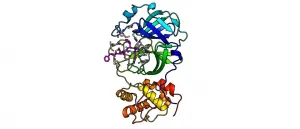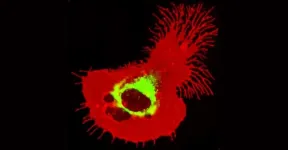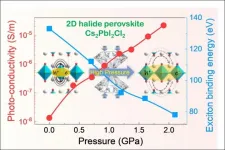Researchers discover SARS-CoV-2 inhibitors
Pharmacists at the University of Bonn: Substances block key step in coronavirus replication
2021-03-03
(Press-News.org) A research team of pharmacists at the University of Bonn has discovered two families of active substances that can block the replication of the SARS-CoV-2 coronavirus. The drug candidates are able to switch off the the key enzyme of the virus, the so-called main protease. The study is based on laboratory experiments. Extensive clinical trials are still required for their further development as therapeutic drugs. The results have now been published in the journal Angewandte Chemie.
In order for the SARS-CoV-2 coronavirus to replicate, it relies on the main protease as a key enzyme. The virus first has its genome translated from RNA into a large protein strand. The viral main protease then cuts this protein chain into smaller pieces, from which the new virus particles are formed. "The main protease is an extremely promising starting point for coronavirus drug research," says Prof. Dr. Christa E. Müller of the Pharmaceutical Institute at the University of Bonn. "If this enzyme is blocked, viral replication in the body's cells is stopped." The researcher is a member of the Transdisciplinary Research Area "Life and Health" at the University of Bonn.
The pharmaceutical chemists designed a large number of potential inhibitors based on the structure of the main protease and the mechanism by which the important virus-replicating enzyme works. "A suitable inhibitor must bind sufficiently tightly to the main protease to be able to block its active site," says Prof. Dr. Michael Gütschow, who heads an independent research group on such inhibitors at the Pharmaceutical Institute of the University of Bonn.
Fluorescent test system
Then the experimental phase began. The researchers developed a new test system for high-throughput screening. They offered the main protease a substrate to which a reporter molecule was coupled. When the protease catalytically cleaved this coupling, the fluorescence of the product was measurable. However, if a simultaneously administered inhibitor successfully blocked the activity of the protease, there was no fluorescence. "For most of the test compounds, we observed no enzyme inhibition. But on rare occasions in our comprehensive tests, fluorescence was suppressed: These were the hits we had hoped for in our search for inhibitors of the viral protease," reports Gütschow.
Like chewing gum at the catalytic center
The researchers' high-throughput screening showed two classes of drugs that appeared to be particularly promising. Customized compounds of both classes were then newly synthesized. They stick to the main protease like chewing gum and block the crucial catalytic center, which prevents the main protease from preparing the virus replication. "Some of the compounds even have another effect," Müller reports. "They also inhibit a human enzyme that helps the virus enter body cells."
The participants contributed very different expertise to the study. "Only through great collaboration have we been able to design, synthesize and biochemically characterize suitable drug candidates," says Gütschow. "The best compounds represent promising lead structures for drug development," according to Müller. However, extensive clinical trials have yet to prove whether these candidates also inhibit SARS coronavirus-2 replication in humans, Gütschow adds.
INFORMATION:
Participating institutions and funding
In addition to the lead University of Bonn, the Institute of Virology and Immunobiology at the University of Würzburg was also involved. The study was supported with funds from the Pharmaceutical Institute of the University of Bonn.
Publication: Julian Breidenbach, Carina Lemke, Thanigaimalai Pillaiyar, Laura Schäkel, Ghazl Al Hamwi, Miriam Diett, Robin Gedschold, Nina Geiger, Vittoria Lopez, Salahuddin Mirza, Vigneshwaran Namasivayam, Anke C. Schiedel, Katharina Sylvester, Dominik Thimm, Christin Vielmuth, Lan Phuong Vu, Maria Zyulina, Jochen Bodem, Michael Gütschow and Christa E. Müller: Targeting the Main Protease of SARS-CoV-2: From the Establishment of High Throughput Screening to the Design of Tailored Inhibitors, Angewandte Chemie, DOI: 10.1002/anie.202016961
Contacts:
Prof. Dr. Christa E. Müller
Pharmazeutisches Institut
Universität Bonn
Tel. +49 (0)228/732301
E-mail: christa.mueller@uni-bonn.de
Prof. Dr. Michael Gütschow
Pharmazeutisches Institut
Universität Bonn
Tel. +49 (0)228-732317
E-mail: guetschow@uni-bonn.de
[Attachments] See images for this press release:

ELSE PRESS RELEASES FROM THIS DATE:
2021-03-03
For women who had participated in both of their previous two screening examinations, the incidence of breast cancers proving fatal within 10 years of diagnosis was 50 per cent lower than in women who did not attend either of the last two screening examinations. Compared with women who attended only one of the two previous screens, women who attended both had a significant 22-33 per cent reduction in breast cancer mortality.
Lead author, Professor Stephen Duffy of Queen Mary University of London, said: "While there is ample evidence that breast cancer mortality is reduced in those who attend screening, these results demonstrate that repeated attendance ...
2021-03-03
Gas around black holes and interstellar medium distribution are key factors in understanding the growth of supermassive black holes and the evolution of their host galaxies. However, as a crucial parameter, gas density is hard to be determined reliably, because the general method is not applicable to all quasars.
Researchers from the University of Science and Technology of China (USTC) of the Chinese Academy of Sciences (CAS) for the first time detected a "sharp rise" signature in the detection rate of broad absorption line (BAL) variations, which in turn deduced ionized gas density. The work was published in The Astrophysical Journal Letters on January 11, 2021.
The ionization state of a gaseous outflow requires a ...
2021-03-03
New research shows that people diagnosed with a genetic condition, called alpha-1 antitrypsin deficiency (AATD), are far more likely to stop smoking and therefore prevent the development of lung disease.
The study, led by researchers from RCSI University of Medicine and Health Science, is published in COPD: Journal of Chronic Obstructive Pulmonary Disease.
It is estimated that 265,000 people on the island of Ireland are affected by either severe or moderate AATD, but the vast majority of people with AATD have not been diagnosed.
Previously, it was assumed that only people with severe AATD were at risk of lung disease. Recent Irish research has shown that people with the far more common moderate form ...
2021-03-03
Lithium-ion battery fire hazards are extensive worldwide and such failure can have a severe implication for both smartphones and electric cars, says the head of the group and Professor in the Department of Electrochemistry at St Petersburg University Oleg Levin. 'From 2012 to 2018, 25,000 cases of catching fire by a wide range of devices in the USA only were reported. Earlier, from 1999 to 2012, only 1,013 cases were reported. The number of fire incidents is increasing as is the number of the batteries being used,' he said.
Among the main reasons why lithium ion batteries catch fire or explode are overcharging, short circuit, and others. As a result, the battery is overheated and the battery ...
2021-03-03
Semaglutide, an injectable medication taken once a week, offers a nonsurgical way to reduce weight and treat obesity. It could help the more than 70 million adults in the United States who struggle with this chronic condition, says Ildiko Lingvay, M.D., M.P.H., M.S.C.S., professor of internal medicine and population and data sciences at UTSW and lead author of the study, published today in The Lancet.
People with diabetes benefit greatly from weight loss, yet they have a much harder time losing weight compared with those without diabetes, Lingvay says. This ...
2021-03-03
WEHI researchers have uncovered a process cells use to fight off infection and cancer that could pave the way for precision cancer immunotherapy treatment.
Through gaining a better understanding of how this process works, researchers hope to be able to determine a way of tailoring immunotherapy to better fight cancer.
Led by Dr Dawn Lin and Dr Shalin Naik and published in Nature Cell Biology, the research provides new insight into the way cells adapt to fight infection.
This research lays the foundation for future studies into the body's response to environmental stressors, such as injury, infection or cancer, at a single cell level.
At a glance
WEHI researchers have studied dendritic ...
2021-03-03
HPSTAR scientists Dr. Songhao Guo and Dr. Xujie Lü report three orders of magnitude increase in the photoconductivity of Cs2PbI2Cl2 from its initial value, at the industrially achievable level of 2 GPa, using pressure regulation. Impressively, pressure regulating the 2D perovskite's excitonic features gains it 3D compound characteristics without diminishing its own advantages, making it a more promising material for photovoltaic and photodetector applications. Their study is published as a Cover article in the latest issue of the Journal of the American Chemical Society.
Two-dimensional (2D) halide perovskites have recently emerged for photovoltaic and optoelectronic ...
2021-03-03
In a report summary released today Thomas McAndrew, a computational scientist and assistant professor at Lehigh University's College of Health includes probabilistic forecasts of the impact of vaccines and variants on the U.S. COVID trajectory over the next few weeks. The goal of the report, says McAndrew, is "to support public health officials, infectious disease modeling groups, and the general public"
Report highlights:
A consensus of 91 forecasters predicts that the B.1.1.7. variant will be found in 42% of all genetic sequences with an S-gene mutation in the first two weeks of March and in 72% in all sequences between ...
2021-03-03
Researchers have captured the first detailed images of newborn babies' lungs as they take their first breaths.
The research, led by the Murdoch Children's Research Institute (MCRI) and published the American Journal of Respiratory and Critical Care Medicine, provides a breakthrough in understanding the events around a baby's first breath, why healthy babies cry at birth and provides clues to improving preterm babies' survival chances and long term health outcomes.
About 10 per cent of newborns, and almost all preterm infants, need resuscitation because their lungs do not properly fill with air at birth (a process called lung aeration). Despite ...
2021-03-03
New research from UBC finds that higher life satisfaction is associated with better physical, psychological and behavioural health.
The research, published recently in The Milbank Quarterly, found that higher life satisfaction is linked to 21 positive health and well-being outcomes including:
a 26 per cent reduced risk of mortality
a 46 per cent reduced risk of depression
a 25 per cent reduced risk of physical functioning limitations
a 12 per cent reduced risk of chronic pain
a 14 per cent reduced risk of sleep problem onset
an eight per cent higher likelihood of frequent physical activity
better psychological well-being on ...
LAST 30 PRESS RELEASES:
[Press-News.org] Researchers discover SARS-CoV-2 inhibitors
Pharmacists at the University of Bonn: Substances block key step in coronavirus replication




